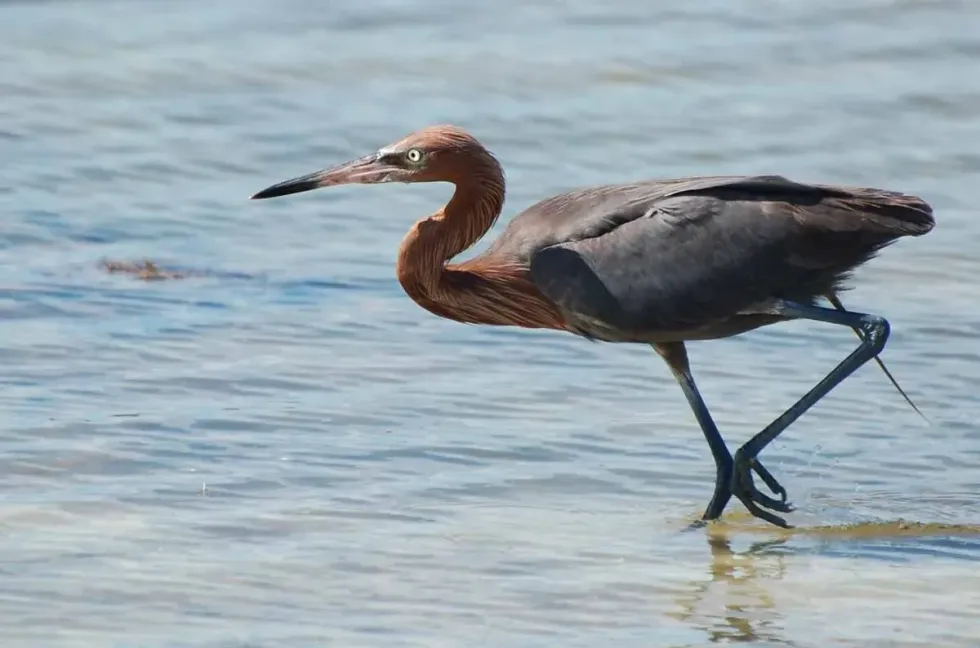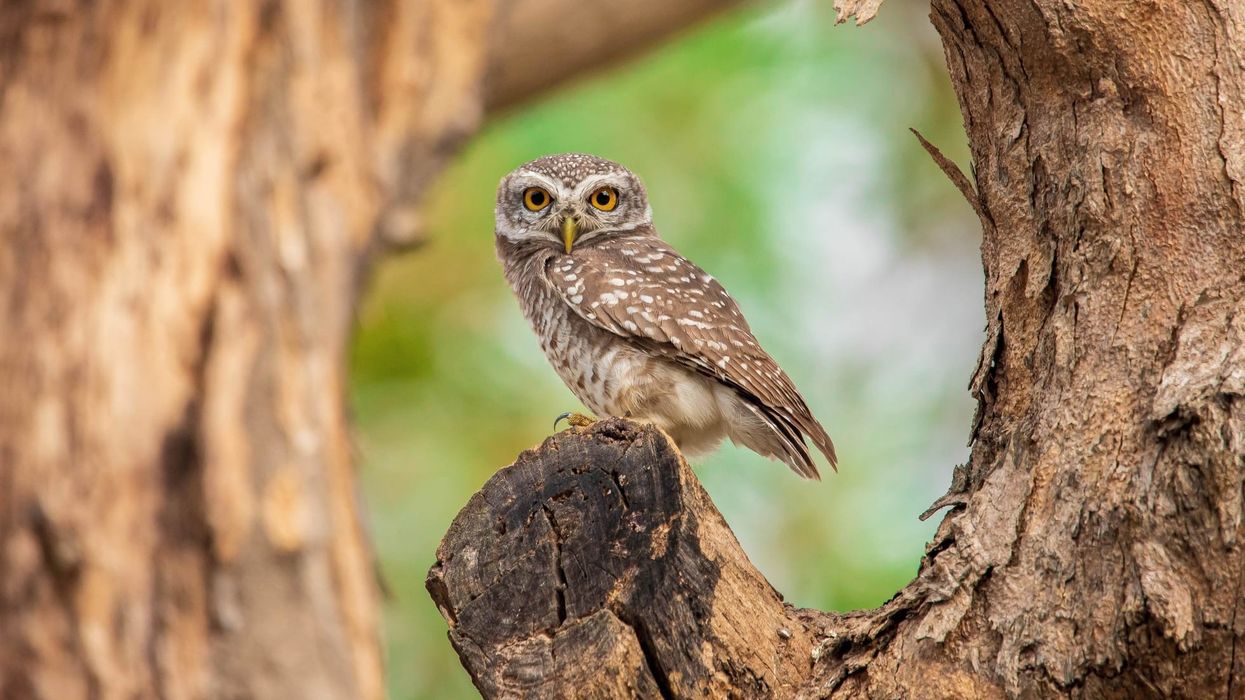The reddish egret (Egretta rufescens) was known as the rarest egret species in North America in the late 1800s. These birds are medium-sized herons that are mostly found in the Bahamas, The Caribbean, the Gulf Coast of the United States, and Mexico.
The reddish egret (Egretta rufescens) belongs to the family Ardeidae in the order of Pelecaniformes. This bird is smaller in size than the great egret and the great blue heron.
The male and the female reddish egret are similar in appearance and both have cobalt feet. Sexual dimorphism can be seen and females comparatively have a smaller body than males.
There are two color morphs of the reddish egret. The egret species has been listed as Near Threatened by the IUCN Red List and efforts for its conservation are being conducted. After reading these interesting facts about plumage dimorphism in the reddish egret, do check our other articles on peahens and bee hummingbirds.
Reddish Egret Interesting Facts
What type of animal is a reddish egret?
The reddish egret is a medium-sized bird that belongs to the species of herons. The adult reddish egrets have two distinctive colors. The adult dark morph and the adult white morph have plumages of different colors.
What class of animal does a reddish egret belong to?
The reddish egret belongs to the class of Aves. These nesting birds are found mainly in coastal regions, bays, estuaries, and islands. These nesting birds feed mostly on fishes and are typically carnivorous in nature.
How many reddish egrets are there in the world?
The Texas Parks and Wildlife Department has determined 1,200 to 2,000 pairs of breeding reddish egrets in Central and Northern America alone. The estimated global population of reddish egrets is 5,000 pairs. Egrets were also considered to be endangered in the late 19th century due to extensive plume hunting.
Where does a reddish egret live?
Reddish egret population lives alongside coastal areas near shallow waters where this bird can hunt for fish. These nesting birds can also be found in the Gulf Coast of the United States and other estuaries and bays. Flocks of reddish egrets also breed in Florida.
What is a reddish egret's habitat?
Reddish egrets are residents of Central Americas' coastal islands. Their preferred habitat is coastal tidal flats, salt marshes, salt pans, along bays, and estuaries which are protected and near calm, shallow water where these birds can feed on fishes.
Who do reddish egrets live with?
Reddish egrets nest in colonies and take care of the eggs together by incubating them. These birds are often seen in mangroves and low bushes with nests of other heron species. Mixed flocks of herons often migrate to breeding grounds.
How long does a reddish egret live?
The life expectancy of reddish egrets is 12 years. These birds are beautiful heron species that breed typically in Central America. Some specimens of the reddish egret have been recorded to have a lifespan of 22 years.
How do they reproduce?
The reddish egret reaches sexual maturity at four years of age. Pre-mating ritual is commonly seen and loud vocals are uttered along with body displays. Males and females do not consider if their mate is of the same color morph.
These birds can be found in large nesting colonies along with other species of herons. Three to six bluish-green eggs are laid and are incubated by both the male and female for 22-36 days. The hatchling stays in the nest for another 30 days and then starts flying.
What is their conservation status?
The conservation status of reddish egrets is classified as Near Threatened by the IUCN Red List. Their population is constantly decreasing due to loss and degradation of habitat, mainly caused due to increased human activity along the coastal regions.
Recreational activities and unsuitable ecological conditions have also caused a decline in their population. There are only 300 pairs of reddish egrets left in Florida.
Reddish Egret Fun Facts
What do reddish egrets look like?

Reddish egrets are cousins of swashbucklers and look pale blue-green. These birds belong to the species of herons and have a medium body size. These nesting birds have cobalt blue long legs and have an S-shaped neck.
Their plumage can be found in two different colors. There are two color morphs of this species, the reddish egret white morph, and the reddish egret dark morph.
The dark morph reddish egret has a slate blue body and a red-colored head and neck which is an outgrowth of plumage, making the overall appearance look shaggy and messy. The white morph reddish egret is entirely white in color. Reddish egrets have long, strong legs and a dagger-like bill used to catch fish.
How cute are they?
Reddish egrets are not cute but these nesting birds look absolutely beautiful with their physical attributes. These birds can mostly be found on their breeding grounds in large flocks.
How do they communicate?
During the breeding season, reddish egrets toss their heads and hop happily to attract mates. These nesting birds also snap their bills repetitively.
Body displays are common, which can intimidate other males and also attract females. To woo a female reddish egret, a male can walk or dance around in circles by flapping their wings or simply holding one of their wings up high. These birds are terrestrial in nature and will aggressively protect their territory from other invaders.
How big is a reddish egret?
The reddish egret range of weight is 1.32 lb but some larger specimens of the reddish egret have been recorded to have a bodyweight of 1.85 lb. Reddish egrets are smaller than the blue herons and great herons.
Their average body length is 27-32 in with a wingspan of almost 46-49 in. The females have a smaller body compared to the males.
How fast can a reddish egret fly?
The reddish egret files at a speed of 25 miles per hour. This bird species has a slow and relaxed flight.
When the availability of prey is high, reddish egrets feed together but are mostly found foraging alone. These birds fly at an average speed with steady wing-flapping. This bird has long legs, which enables it to run at extremely fast speeds.
How much does a reddish egret weigh?
The average weight of an adult reddish egret is 1.32 lb. But few larger specimens of the reddish egret can weigh more than 1.85 lb. Female reddish egrets are smaller than the males.
What are their male and female names of the species?
There are no distinctive names for the male and female species of reddish egrets.
What would you call a baby reddish egret?
There is no specific name for a baby reddish egret juvenile. These birds of North America are commonly called hatchlings, nestlings, juvenile reddish egrets, chicks, or fledglings.
What do they eat?
The reddish egret feeding strategy is planned and they mostly prey on small fish. Killifish are their staple prey. Other fish like mollusks, minnows, mullets, shrimps, insects, and tadpoles are also eaten by reddish egrets. This heron species occasionally feeds on frogs and crustaceans as well.
Are they aggressive?
No, reddish egret dancing is adorable and this heron is very lazy and social with other species of herons. They are aggressive towards other males who try to steal their mates or territories.
Would they make a good pet?
No, it is illegal to keep reddish egrets as pets as they are classified as a Near Threatened species by the IUCN Red List. Though they have a long lifespan, they cannot be kept as pets as an apartment habitat is not suitable for them.
Did you know...
The reddish egret dances and hops around their prey and do not stab them as soon as they are spotted. They are fun to watch when they are feeding.
Sometimes reddish egrets also create a shadow in their water with their wings which attracts small fish which eventually becomes their hunting behavior. They are crepuscular in nature, which means they are most active during dusk and dawn.
What were reddish egrets originally hunted for?
Reddish egrets were originally hunted for their reddish egret plume.
How are reddish egrets protected?
Reddish egrets are protected under the 1918 Migratory Bird Treaty Act of the United States which made it illegal for hunters to shoot down reddish egrets. A few species are also protected under the Lacey Act.
Here at Kidadl, we have carefully created lots of interesting family-friendly animal facts for everyone to discover! Learn more about some other birds including the snowy plover and the American golden plover.
You can even occupy yourself at home by drawing one of our Reddish egret coloring pages.










